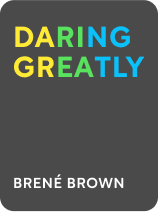

This article is an excerpt from the Shortform book guide to "Daring Greatly" by Brené Brown. Shortform has the world's best summaries and analyses of books you should be reading.
Like this article? Sign up for a free trial here .
Why is there such an antithesis between vulnerability and leadership? Why is showing vulnerability considered a weakness in leadership?
Vulnerability is often considered as a weakness and something to hide, especially in the world of leadership. According to Brene Brown, however, the most effective leaders are those who are brave enough to embrace vulnerability in their leadership.
Read about vulnerability and leadership.
Vulnerability and Leadership
Vulnerability and leadership are often seen as opposing qualities. According to Brene Brown, however, the most effective leaders are those who are brave enough to embrace vulnerability and show up as they are.
What Is a Leader?
Brown defines a leader as someone who sees possibilities and potentials, and makes themselves responsible for actualizing them. Anyone who is willing to step into that responsibility has the potential to lead.
Why Is It So Difficult to Be a Leader in Our Culture of Scarcity?
To be a true leader, you need to innovate. People have such a fear of not being good enough, innovation is challenging to nurture in the workplace. People are deriving too much of their worth from external validation, and as a result, feel unable to take the risks needed to cultivate innovative ideas.
What Are the Greatest Obstacles to Innovation?
Obstacle #1—Disengagement. Disengagement is a protective response. It occurs when the fear of pain overrides the desire to connect. You can only experience so much shame before you need to disengage. Disengagement corrodes your willingness to show up and connect meaningfully. If, over time, you continually allow how others respond to your ideas to determine how you feel about yourself, and people reject your ideas, you lose the courage necessary to connect with and express your creativity.
Obstacle #2: Risk Avoidance. Creativity and learning are, by nature, unpredictable and uncertain experiences. They can only occur as a result of taking risks and being vulnerable. You need to be able to experience failure to learn and grow.
What Do These Obstacles Look Like In Our Schools and Workplaces?
Put simply, they look like cultures based in shame. These types of environments are unsustainable. They facilitate the erosion of self-esteem and self-worth. When people experience shame long enough, defense mechanisms automatically arise as protection. The number one defense mechanism that will arise in a shame-prone environment is disengagement.
How Can You Tell Shame Has Taken Over The Culture?
Usually, you are on your way to shame culture in your school or organization if you see any of the following red flags:
Red Flag #1—Blaming
- For example, let’s say you are a high school student, and you have a teacher who doesn’t effectively teach the concepts they are covering. You then take a quiz, which you fail. Instead of acknowledging there may have been gaps in the curriculum, your teacher tells you that you need to pay better attention in class.
Red Flag #2—Gossip
- For example, you overhear from coworkers that your boss has been making comments about your work performance to colleagues when you’re not around.
Red Flag #3—Favoritism
- For example, let’s say one of your coworkers spends a lot of time building a friendly relationship with your mutual supervisor. You work hard and consistently demonstrate high-quality work. Your coworker is lazier, but personable. You notice that, despite the fact that your numbers and work performance are objectively better than this coworker, when you both apply for a promotion, it goes to the coworker instead.
Red Flag #4—Name-Calling
- For example, you make a mistake at work, and in the next company meeting, your supervisor calls you out in front of everyone, describing you as incompetent.
Red Flag #5—Harassment
- For example, let’s say you are an LGBTQ high school student. One day you are walking to class, and your classmates start directing cruel comments at you. One of your teachers witnesses it, but does nothing.
What Prevents Us From Effectively Addressing Shame in the Workplace?
Inadequate or nonexistent feedback. Workplaces that lack shame resilience typically do not have the uncomfortable conversations necessary for growth. There are two components to this:
- We don’t know how to manage our discomfort.
- We don’t know how to give feedback that is empowering and motivating.
4 Practices to Develop Shame Resilience in Leaders and Organizations
Practice #1—Support and Uplift
Support and uplift organizations and leaders who demonstrate willingness to build shame-resilient communities.
Practice #2—Be Vigilant of Shame
Be observant and notice where shame may be developing and spreading.
Practice #3—Honest Feedback
Support those within the culture to stay engaged through honest discussions about common struggles and potential solutions.
Practice #4—Choose Strong Leaders
Make sure those running an organization can differentiate shame from guilt, and are able to guide their team in a way that feels empowering and engaging.
Another crucial component of rehumanizing our cultural environments is normalizing Wholehearted feedback.
What Is Wholehearted Feedback?
Wholehearted feedback has four core qualities.
Quality #1—Honest, Constructive, and Engaged
This kind of feedback is transformative, because it facilitates a mutually productive dynamic for professional development. When you are transparent, solution or strength-focused, and fully present, you set the stage for the kind of vulnerability that encourages creative growth.
Quality #2—Can Be Uncomfortable, But Motivates Change
Discomfort is normal and necessary for growth. If you resist the discomfort, there is no impetus for change. If you embrace it, you can use the discomfort to identify the path from where you are, to where you want to be.
Quality #3—Takes a “Strengths” Approach
This approach isn’t about focusing only on the positive and ignoring what needs work, but about taking stock of strengths in order to utilize those strengths to improve areas that need work.
- Example: You are an employer. You have a popular, well-liked employee who spends a lot of time socializing with other coworkers, instead of taking initiative on work projects. You call this employee into your office to discuss this. Instead of admonishing the employee for their socializing, you point out to them that they have a lot of power and influence with their peers, and let them know this is a quality leaders possess. You work with the employee to use their personability and influence to inspire the team to reach new heights together. Effectively, what you have done is use this employee’s strength to address areas needing improvement, and not only does this specific employee’s performance improve, but the entire team is elevated as a result.
Quality #4—Rooted in Conscious Vulnerability
Vulnerability is inherently present in any feedback process, whether the process is wholehearted or not. Feedback is vulnerable for both parties, whether on the giving or receiving end, because both parties are engaging with risk and uncertainty during the process. It’s important to resist the urge to armor yourself during this process. It’s more productive to be present with uncertainty and meet one another with equal vulnerability.
- Example of resisting vulnerability in the feedback process: You are a teacher, and you have a student who repeatedly fails to turn in assignments. You call this student into your office, and tell them if they don’t start turning in their work, you’re going to fail them in the class. They shut down, and eventually stop even showing up to class.
- Example of embracing vulnerability in the feedback process: Consider the same example from above. Instead of giving the student an ultimatum, you share that you’ve noticed they haven’t been turning in their work. You let them know you’re concerned, and you want them to feel able to engage with their learning process. Maybe you let them know about a time you struggled in school when you were their age. You ask them what you can do to help them complete their work. Together, you come up with a plan of action that will help them feel more supported. They steadily begin improving, and you notice greater engagement in class as well.
Reconciling Vulnerability and Leadership
If we want to build a culture of wholeheartedness in our schools, workplaces, and other significant areas of society, we must let go of the antithesis between vulnerability and leadership and support leaders who engage in wholehearted feedback and build environments that nurture conscious, innovative connection.

———End of Preview———
Like what you just read? Read the rest of the world's best book summary and analysis of Brené Brown's "Daring Greatly" at Shortform .
Here's what you'll find in our full Daring Greatly summary :
- What it means to live Wholeheartedly
- The 3 things you need to feel happy and healthy
- How scarcity and shame prevent you from achieving a Wholehearted life






